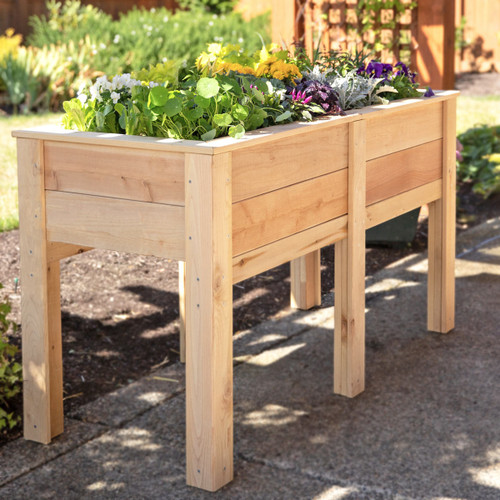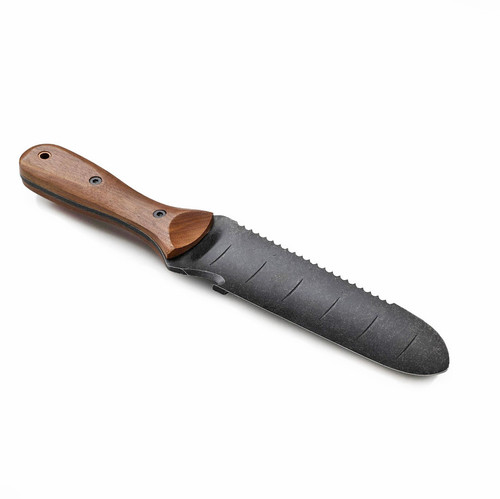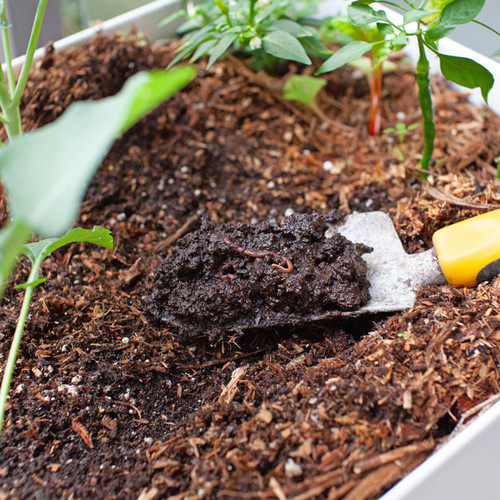
Free Shipping Ships within 3-5 Business Days: Processing time varies: Learn more
Easily grow nearly any vegetable, herb or flower organically with the Garden Tower 2! This vertical gardening system eliminates weeding, nutrient loss and most water loss associated with conventional gardening!
Deliver nutrients to your plant roots for hydroponic-like growth rates without the price tag and difficulty.
Overview
The Garden Tower 2 gives you space for 50 individual plants, as well as a large vermicomposting column down the middle. This system utilizes your kitchen scraps to produce nutrient rich compost that is then made accessible to the roots of your flowers, herbs or vegetables.
The Garden Tower 2 is a great option for those looking to save space on a patio, balcony, store-front or even in a greenhouse. It's made from food-grade, USA-made HDPE (non-toxic, BPA & PVC free plastic) components, FDA-approved dye, and UV-protection antioxidant package for health, durability, and recyclability.
Optional Caster Wheel Kit: The caster wheel kit allows you to easily move your tower around your porch, patio or any hard, relatively even, surface. When in operation, these units weigh ~220lbs. Included is a USA-made double powder coated heavyweight steel support structure, hardware, and three heavy-duty double locking (rotational axis locking) triple ball bearing black casters.
Features & Benefits:
- Create organic fertilizer delivered right to your plants in one system
- Eliminate weeding, and most water and nutrient loss
- Made from food safe & BPA-free polyethylene
- 50 individual spaces for different plants in just 4 square feet
- Holds 6 cubic feet of soil
- Rotating tower
- Collect both the castings and "worm tea"
- Odorless operation
- Made in the USA
- 3-year manufacturer's warranty
Please note the Garden Tower does not include soil, seeds, bedding material or worms. Composting worms can be purchased here, or from a variety of local and online sources.
Using Your Garden Tower
The Garden Tower planter works on an aerobic (with air) composting principal, so light, fluffy soil is best. Issues can arise from over-compaction, either in the soil column or in the compost column. Straw, grass, leaves & coir are good bedding for worms and should periodically be added directly in the compost column to avoid compaction.
Start with at least 250-500 composting worms for the center compost tube. Add at least 25-50 earthworms into the soil column.
A general watering schedule during the growing season is 4-6 gallons of water every 2-3 days. That being said, this will vary for everyone, and we recommend watering with a container instead of a hose to avoid over-watering.
Every so often, once the column is full, you can empty some of the finished compost from the bottom. To do so, ensure the drawer has no water in it and pull the screen out half way to allow vermicompost to exit the bottom of the compost column, and fall into the drawer. You can use the finished compost in your gardens, and the liquid that drains down through the tower is also an ideal fertilizer.
What to Feed your Worms:
Most fruit and vegetable scraps, pulps from juicer
Cooked food
Tea leaves/bags and coffee grounds
Crushed/ground eggshells
Hair, vacuum cleaner dust, soiled paper, tissue, paper towels, shredded egg cartons
Shredded newspaper, cardboard, sawdust (untreated), wood ash
Lawn clippings in small quantities, weeds, clippings, prunings, dirt and leaves
What to Avoid or Limit:
Limit citrus and acidic fruit skin
Limit bread, pasta and other wheat based products
Avoid hard fruit pits
Avoid spice foods, onions, garlic and leeks
Avoid animal products such as meat, dairy, or fats
Avoid shiny paper
Do not feed rotten food to your worms
Flower, Herb & Vegetable Recommendations:
Below is a shortlist of what we recommend planting in your Garden Tower!
Vegetables
Amaranth (vegetable type), Arugula, Beans, Broccoli, Brussels Sprouts, Cabbage, Cauliflower, Chard, Chicory, Collards, Cucumbers, Eggplant, Endive, Escarole, Gourds, Kale, Leeks, Lettuce, Melons, Mesclun, Mustard Greens, Dwarf Okra, Peas, Peppers, Radicchio, Sorrel, Spinach, Squash, Strawberries, Tomatoes
Note: vines such as squash and melons grow nicely from the bottom holes, trailing onto an in Tower trellis or a railing, chair, stool or piece of garden art)
Herbs
Angelica, Anise Hyssop, Basil, Calendula, Catmint, Catnip, Chamomile, Chervil, Chives, Cilantro, Dandelion, Dill, Echinacea, Feverfew, Flax, Garlic Chives, Goldenseal Hyssop, Lavender, Fennel, Lemon Balm, Marjoram, Milk Thistle, Mint, Nettle, Oregano, Parsley, Passion Flower, Pleurisy Root, Rosemary, Sage, Salad Burnet, Saltwort, Savory, Shiso, Stevia, Thyme, Valerian, Wormwood
Flowers
Edible Flowers: Calendula, Carthamus, Dianthus, Marigolds, Nasturtiums, Pansies, Salvia, Violas
Ornamental Flowers: Ageratum, Amaranth, Ammi, Aster, Bells of Ireland, Bupleurum, Morning Glory, Nigella, Petunia, Phlox, Polygonum, Poppy, Ptilotus, Rudbeckia, Safflower, Salpiglossis, Sanvitalia, Scabiosa, Snapdragon, Stock, Strawflower, Sweet Peas, Verbena, Yarrow, Zinnia
Taking Care of Your Worms
Worms are low maintenance and will be happy as long as they are fed, have enough moisture, and are kept between 40° and 80° F. Worms should be protected from extreme temperatures. The vertical tower planters can be used successfully both indoors and outdoors, and they are a great space-saver in a greenhouse!
You don't need to feed your worms every day – just add scraps as you have them. We recommend a generous handful or two of food every couple of days. Worms can survive up to 2 weeks without any new food. Worms reproduce inside the tower according to their space limitations. They will regulate their own population, so you never need to worry about overcrowding your tower.
It is very important that the Garden Tower compost is not overfed. Worms prefer to eat their food as it begins to decompose, but not if it has become slimy and smelly.
In Mid & Northern regions, overwintering is possible during milder winters. In a cold winter, we suggest that the center compost should be removed (with worms) and placed in a 1-foot deep hole in the ground outside of your dwelling (if accessible). Alternatively, you could empty the contents and worms into a indoor worm composting system.
Description
Easily grow nearly any vegetable, herb or flower organically with the Garden Tower 2! This vertical gardening system eliminates weeding, nutrient loss and most water loss associated with conventional gardening!
Deliver nutrients to your plant roots for hydroponic-like growth rates without the price tag and difficulty.
Overview
The Garden Tower 2 gives you space for 50 individual plants, as well as a large vermicomposting column down the middle. This system utilizes your kitchen scraps to produce nutrient rich compost that is then made accessible to the roots of your flowers, herbs or vegetables.
The Garden Tower 2 is a great option for those looking to save space on a patio, balcony, store-front or even in a greenhouse. It's made from food-grade, USA-made HDPE (non-toxic, BPA & PVC free plastic) components, FDA-approved dye, and UV-protection antioxidant package for health, durability, and recyclability.
Optional Caster Wheel Kit: The caster wheel kit allows you to easily move your tower around your porch, patio or any hard, relatively even, surface. When in operation, these units weigh ~220lbs. Included is a USA-made double powder coated heavyweight steel support structure, hardware, and three heavy-duty double locking (rotational axis locking) triple ball bearing black casters.
Features & Benefits:
- Create organic fertilizer delivered right to your plants in one system
- Eliminate weeding, and most water and nutrient loss
- Made from food safe & BPA-free polyethylene
- 50 individual spaces for different plants in just 4 square feet
- Holds 6 cubic feet of soil
- Rotating tower
- Collect both the castings and "worm tea"
- Odorless operation
- Made in the USA
- 3-year manufacturer's warranty
Please note the Garden Tower does not include soil, seeds, bedding material or worms. Composting worms can be purchased here, or from a variety of local and online sources.
Using Your Garden Tower
The Garden Tower planter works on an aerobic (with air) composting principal, so light, fluffy soil is best. Issues can arise from over-compaction, either in the soil column or in the compost column. Straw, grass, leaves & coir are good bedding for worms and should periodically be added directly in the compost column to avoid compaction.
Start with at least 250-500 composting worms for the center compost tube. Add at least 25-50 earthworms into the soil column.
A general watering schedule during the growing season is 4-6 gallons of water every 2-3 days. That being said, this will vary for everyone, and we recommend watering with a container instead of a hose to avoid over-watering.
Every so often, once the column is full, you can empty some of the finished compost from the bottom. To do so, ensure the drawer has no water in it and pull the screen out half way to allow vermicompost to exit the bottom of the compost column, and fall into the drawer. You can use the finished compost in your gardens, and the liquid that drains down through the tower is also an ideal fertilizer.
What to Feed your Worms:
Most fruit and vegetable scraps, pulps from juicer
Cooked food
Tea leaves/bags and coffee grounds
Crushed/ground eggshells
Hair, vacuum cleaner dust, soiled paper, tissue, paper towels, shredded egg cartons
Shredded newspaper, cardboard, sawdust (untreated), wood ash
Lawn clippings in small quantities, weeds, clippings, prunings, dirt and leaves
What to Avoid or Limit:
Limit citrus and acidic fruit skin
Limit bread, pasta and other wheat based products
Avoid hard fruit pits
Avoid spice foods, onions, garlic and leeks
Avoid animal products such as meat, dairy, or fats
Avoid shiny paper
Do not feed rotten food to your worms
Flower, Herb & Vegetable Recommendations:
Below is a shortlist of what we recommend planting in your Garden Tower!
Vegetables
Amaranth (vegetable type), Arugula, Beans, Broccoli, Brussels Sprouts, Cabbage, Cauliflower, Chard, Chicory, Collards, Cucumbers, Eggplant, Endive, Escarole, Gourds, Kale, Leeks, Lettuce, Melons, Mesclun, Mustard Greens, Dwarf Okra, Peas, Peppers, Radicchio, Sorrel, Spinach, Squash, Strawberries, Tomatoes
Note: vines such as squash and melons grow nicely from the bottom holes, trailing onto an in Tower trellis or a railing, chair, stool or piece of garden art)
Herbs
Angelica, Anise Hyssop, Basil, Calendula, Catmint, Catnip, Chamomile, Chervil, Chives, Cilantro, Dandelion, Dill, Echinacea, Feverfew, Flax, Garlic Chives, Goldenseal Hyssop, Lavender, Fennel, Lemon Balm, Marjoram, Milk Thistle, Mint, Nettle, Oregano, Parsley, Passion Flower, Pleurisy Root, Rosemary, Sage, Salad Burnet, Saltwort, Savory, Shiso, Stevia, Thyme, Valerian, Wormwood
Flowers
Edible Flowers: Calendula, Carthamus, Dianthus, Marigolds, Nasturtiums, Pansies, Salvia, Violas
Ornamental Flowers: Ageratum, Amaranth, Ammi, Aster, Bells of Ireland, Bupleurum, Morning Glory, Nigella, Petunia, Phlox, Polygonum, Poppy, Ptilotus, Rudbeckia, Safflower, Salpiglossis, Sanvitalia, Scabiosa, Snapdragon, Stock, Strawflower, Sweet Peas, Verbena, Yarrow, Zinnia
Taking Care of Your Worms
Worms are low maintenance and will be happy as long as they are fed, have enough moisture, and are kept between 40° and 80° F. Worms should be protected from extreme temperatures. The vertical tower planters can be used successfully both indoors and outdoors, and they are a great space-saver in a greenhouse!
You don't need to feed your worms every day – just add scraps as you have them. We recommend a generous handful or two of food every couple of days. Worms can survive up to 2 weeks without any new food. Worms reproduce inside the tower according to their space limitations. They will regulate their own population, so you never need to worry about overcrowding your tower.
It is very important that the Garden Tower compost is not overfed. Worms prefer to eat their food as it begins to decompose, but not if it has become slimy and smelly.
In Mid & Northern regions, overwintering is possible during milder winters. In a cold winter, we suggest that the center compost should be removed (with worms) and placed in a 1-foot deep hole in the ground outside of your dwelling (if accessible). Alternatively, you could empty the contents and worms into a indoor worm composting system.
- Key Feature:
- Use this combined planter / composter to create a beautiful growing display!
- Materials:
- Polyethylene
- Color:
- Terracotta, Sandstone
- Style:
- Worm Composter
- Capacity:
- 6 Cubic Feet
- Shipping Weight:
- 36 lbs.
- Operating Weight:
- 200 lbs.
- Operating Dimensions:
- 25" W x 25" L x 43" H
- Origin:
- Made in the U.S.A.
- Warranty:
- 3-Year Manufacturer's Warranty
- Lead Time:
- Ships within 3-5 Business Days
- No-hassle, 30 day returns
- No sales tax
- Quick shipping
- Secure shopping (SSL, PCI, McAfee Secure)
- In business since 2000
- Member of Better Business Bureau, Green America, and US EPA Watersense
- Carbon-neutral, Family-owned business that promotes sustainability!
Product Videos
Specifications:
- Key Feature:
- Use this combined planter / composter to create a beautiful growing display!
- Materials:
- Polyethylene
- Color:
- Terracotta, Sandstone
- Style:
- Worm Composter
- Capacity:
- 6 Cubic Feet
- Shipping Weight:
- 36 lbs.
- Operating Weight:
- 200 lbs.
- Operating Dimensions:
- 25" W x 25" L x 43" H
- Origin:
- Made in the U.S.A.
- Warranty:
- 3-Year Manufacturer's Warranty
- Lead Time:
- Ships within 3-5 Business Days


























